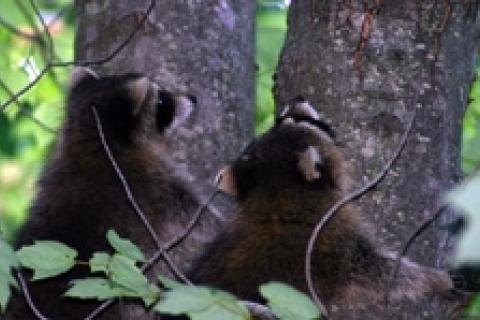
 "Look at that funny looking cat!" the boy yelled. "Where?" asked his father. "It walked under the camper," the boy answered. His father peeked under the picnic table, jumped up as he had seen a ghost and shouted, "Skunk!"
"Look at that funny looking cat!" the boy yelled. "Where?" asked his father. "It walked under the camper," the boy answered. His father peeked under the picnic table, jumped up as he had seen a ghost and shouted, "Skunk!"
Scenarios like this are the norm at campsites, but campers should expect this because whose home is it anyway? Most campgrounds are constructed around wildlife habitat.
The most common habitat that skirts campgrounds is "edge" types of habitat. Edge habitats are where forest and fields, or water and shore meet. Wildlife that prefer edge habitat also provide the camper great wildlife observation opportunities.
The common species that may be spotted during the day, or heard sneaking around the campsite, in most states are the raccoon and skunk. Of course bears are an issue for specific areas, but bears demand an article entirely to themselves. But considering the two most common camp intruders identified above, here are some basic habits and what to expect at camp:
Raccoon: In Germany the raccoon is called a "wash bear" because of the raccoon's eating habits. A raccoon, when close to a water source, dunks its food in water and appears to be washing its meal. What the raccoon is actually doing is looking for unwanted pieces of material and by wetting its paws; it improves its sense of touch. The raccoon eats a variety of items but prefers crayfish, worms, fish, turtles, eggs and corn. The best time of day to see a raccoon is dusk or after dark.
Skunk: The most famous fact of the skunk is its aromatic defense system. Woodlands, edges and tall grassy areas are home to the skunk. Skunks usually take up residence in abandoned burrows of other animals, but will dig their own if necessary. Skunks enjoy eating grubs, insects and eggs of ground-dwelling birds. The skunk normally eats at night, but it is active anytime of the day.
When wildlife visits the campsite, a couple of things could happen. The animal will look around and after finding what it is looking for, or not, it will leave. Trouble begins when campers try to entice visits by feeding the animals.
When animals come into camp and don't find a meal, it will search through the camper's belongings, ransacking the camp in search of a free meal. To avoid this problem, store all food out of reach and preferably in sealed containers.
The second problem is when a person comes in-between the animal and its food. Animals that visit frequently lose fear of humans and may become aggressive. Never try to hand feed or touch a wild animal — the mood of an animal can change in a second and without warning.
An encounter with a wild animal at the campsite are primarily an added highlight to the camping trip. As long as the animal is treated with respect and common sense is used, the experience should be a positive one. Keep your camera at hand so you may catch the wildlife encounter to share with friends and family.
- 2765 views

